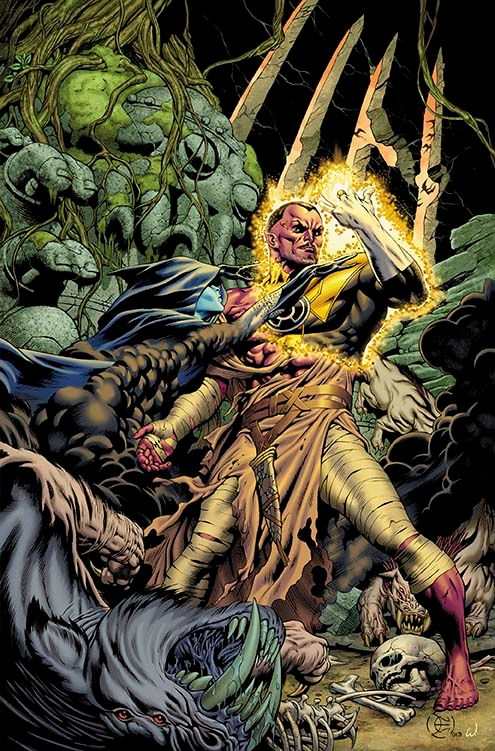"Sinestro" #1 by Cullen Bunn and Dale Eaglesham has the titular villain wandering in exile within "forgotten space", indulging in sulky reflections and a dialogue with himself. After hamming it up like a Byronic hero, albeit one that wrestles with literal beasts, he is has a fateful meeting with Lyssa Drak.
There is some travel and a confrontation scene at the end, as well as a nonsensical opening scene where Sinestro fights space tigers for no apparent reason than to show off his angst in physical form. Despite these attempts to inject some action, "Sinestro" #1 feels like an issue of talking heads because it is bogged down with bulky, unimaginative exposition. The story is dominated by textbox monologues from Sinestro and unrealistic dialogue with Lyssa Drak consisting of play-by-play information dumps. It's a Sinestro history recap that is poorly disguised as conversation, and it's also weak storytelling.
The only saving grace is that there is plenty of information dispensed and "Sinestro" #1 is accessible to new readers, but at great cost to pacing, suspense, characterization and plot. The blatant information dumps also do a disservice to longtime fans of Sinestro, who already know all this stuff.
The other major player in "Sinestro" #1, Lyssa Drak, comes off as equal parts puppet master and crazed groupie. Sinestro calls her mad, but again, this is Sinestro or Bunn telling the reader something, not showing, and she merely comes off as obsessed and manipulative. Her two-dimensional fandom is a bit much. Her costume remains come-hither and her dialogue is laced with sexual double entendres like "my every utterance carries the taste of your glory."
Sinestro shows some character in his concern and grief for his people, the Korugarians. It's awfully convenient for the plot that there are still some around to nudge him out of exile, and the cliffhanger ending lacks punch for the same reason. This nostalgia might make Sinestro sympathetic, except that he reveals himself to be bigoted, content to leave other victims of abduction behind because they aren't his chosen people. Since Bunn and Eaglesham don't show the development of Sinestro's thoughts or feelings, his change of heart about leading the Sinestro Corps isn't entirely convincing.
The most promising part of "Sinestro" #1 is when Bunn breaks new ground instead of rehashing recent Lantern books history. The Paling is a new element, but a strong antagonist would be the best development for "Sinestro," instead of reprising Sinestro alongside known quantities like Lyssa Drak or Arkillo.
Eaglesham's art flows well and creates visual interest for a debut issue that is primarily talking heads, but his take on Sinestro and Lyssa doesn't add anything new or deepen their characterization. Sinestro looks more buff, but if he's been spending more time bench-pressing space tigers, the change of physique passes muster in believability. However, it's a pity, since Sinestro's skinny silhouette was a part of his characterization as the stringy evil intellectual as a foil to Green Lantern's good-natured jock. The facial expressions in "Sinestro" #1 have varying proportions of smugness, anger and a little sorrow. The fear that is arguably the emotional catalyst for Sinestro's choice doesn't register strongly, unfortunately. It doesn't help that Wright's coloring is on the garish side, with clashing colors of cold-toned hues, dominated by the primary colors of red, yellow and blue.
Geoff Johns was able to give Sinestro some depth, but in "Sinestro" #1, the character feels very limited in emotional range and redeeming qualities, not an auspicious start. It does establish a direction for Sinestro and give him a new raison d'etre in finding the remaining Korugarians and rebuilding his Corps, but the path towards those objectives is mechanical and instrumental.

